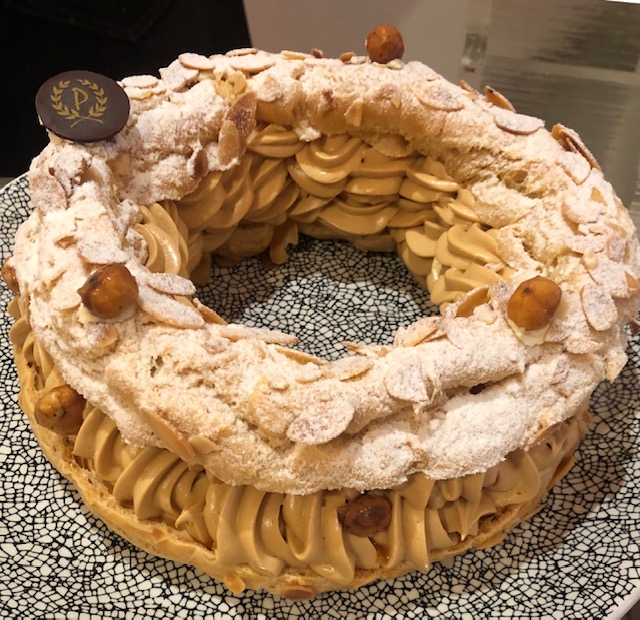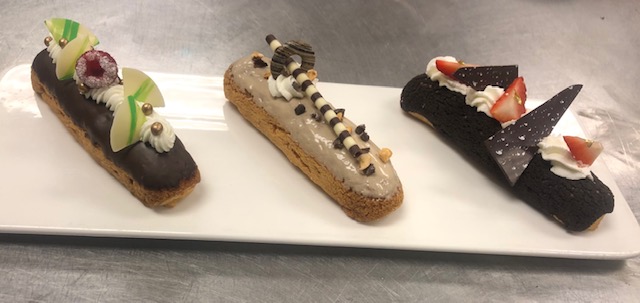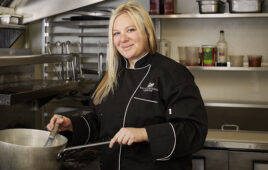For Cody Middleton, one of the Pastry Chefs at the Polo Club of Boca Raton (Fla.), classic pastries offer the perfect platform for chefs to be creative and connect with members in sometimes sentimental ways.
French pastries are the iconic building blocks in any pastry chef’s repertoire. Puff pastry, pâte á choux, and pastry cream are used to create an endless array of desserts and pastries. Classic pastries like éclairs, profiteroles, Paris-Brest, mille-feuille, palmiers, sacristans, jalousie, and tarte Tatin are staples that are sometimes overlooked because of their sometimes humble presentation. Especially within the hyper visual world of social media and the rise of molecular gastronomy, traditional recipes and methods are being abandoned for more scientific applications.
The alluring to transform a humble s’more into a smoked chocolate mousse with malted milk crumb, brûléed marshmallow foam, graham cracker spiced siphon cake, and sea salt caramel caviar is powerful. And while this transformation may be fitting in a modern restaurant, it is not as appealing to the average country club member, especially during a typical dinner service. You might get away with it during a wine dinner, but as chefs, it is our challenge to find the fine balance between traditions that are loved by our members and new and innovative techniques.
Good or bad or indifferent, members at country clubs tend to be conservative. They often appreciate classic desserts that have been studied by every chef that has ever studied pastry. With a few natural outliers, these members look for items that are familiar and reminiscent of traditional pastry shops. They want desserts that focus on flavor and comfort above all else.

Paris-Brest
Food is without a doubt personal. Dessert, especially in clubs, is very personal. A bite of a cannoli can bring back memories of visiting a small pastry shop on the corner of a street in Italy. If we can help our members to relive their food memories through the food we produce at their club, then we have succeeded. And, personally, it’s a satisfying reward that makes what I do so enjoyable.
Truth be told, I experience a similar stroll down memory lane when I get to make classic desserts and pastries. I feel rooted in tradition and history and I am honored to humbly connect with those who prepared the same item before me.
These classics also spark my curiosity and inspire me to push the envelope. Our members are attracted to things that are familiar and recognizable. They also appreciate the talent on their culinary team and they trust us to offer them items that are better and more delicious than they ever expected. Finding the equilibrium between classic flavors and modern flare is something we, as pastry chefs, get to play with on a daily basis.

Trio of Eclairs
Updating the presentation is an easy way to add variety and interest while still being able to preserve the taste that the members love and expect from a particular dish. Something as simple as a dramatic garnish is an effective way to heighten a classic dessert while still preserving its integral flavors. Even tweaking the standard method of production can add variety and interested while keeping a production recognizable.
Take puff pastry for a napoleon, for example. It can be cooked in a panini press to create an interesting design. Timeless desserts like tiramisu, lemon meringue pie, or black forest cake can easily take on a different look as an éclair or cream puff.
Putting these items on buffets is also an easy way to gauge the member favorites. Their opinion is extremely valuable when creating plated desserts for a new menu.
Country clubs across the nation are built on tradition. The same is certainly true for many desserts on our menus. Use the flavors of classic, familiar desserts to recreate show-stopping products that attract your members and excite the chefs who produce them.



